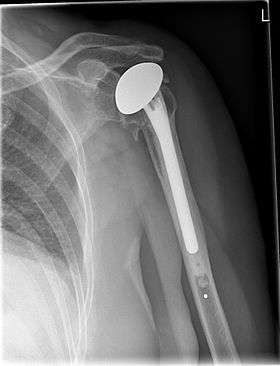Shoulder replacement
| Shoulder replacement | |
|---|---|
| Intervention | |
 X-ray of a shoulder prosthesis | |
| ICD-9-CM | 81.80-81.81 |
| MedlinePlus | 007387 |
Shoulder replacement is a surgical procedure in which all or part of the glenohumeral joint is replaced by a prosthetic implant. Such joint replacement surgery generally is conducted to relieve arthritis pain or fix severe physical joint damage.[1]
Shoulder replacement surgery is an option for treatment of severe arthritis of the shoulder joint. Arthritis is a condition that affects the cartilage of the joints. As the cartilage lining wears away, the protective lining between the bones is lost. When this happens, painful bone-on-bone arthritis develops. Severe shoulder arthritis is quite painful, and can cause restriction of motion. While this may be tolerated with some medications and lifestyle adjustments, there may come a time when surgical treatment is necessary.
Treatment
The main source of shoulder pain, shoulder arthritis, is first managed in early stages with physical therapy and non-steroidal anti-inflammatory (NSAID) drugs.[2] Surgery is considered if pain worsens. There are two primary methods for shoulder replacement; total shoulder replacement and reverse shoulder replacement. Total shoulder replacement involves a replacement of the ball and socket joint. A metal ball is used to replace the humeral head and a plastic socket replaces the cartilage on the glenoid cavity. Once complete this method looks and functions like the original joint.[3]
A reverse shoulder replacement is used to treat patients with severe damage or arthritis of the shoulder joint, and particularly patients with severe rotator cuff tears.[4] It involves the insertion of a hemispherical implant in place of the glenoid instead of the humerus and the cup section being added to the humerus. This method allows the arm to be moved primarily by the deltoid instead of the rotator cuff. An important complication following reverse shoulder replacement is known as scapular notching, in which erosion of the scapular neck is caused by repetitive contact between the humeral component and the inferior scapular neck during adduction.[5] Scapular notching may be more likely in patients with shorter scapular neck lengths.[6]
Non surgery options are preferred treatment for a variety of reasons. Besides not wanting to risk the usual risks of surgery such as infection, shoulder replacement can lead to a variety of complications including rotator cuff tear and glenohumeral instability. However despite these risks, shoulder replacement shows promise with a low rate of complication which depending on the type of surgery is close to 5%.[7]
External links
- Patient X-ray and Image gallery demonstrating anatomic total shoulder replacement and reverse shoulder replacement surgery
- Information for Patients - Total Shoulder Replacement Arthroplasty for Shoulder Arthritis
References
- ↑ American Academy of Orthopaedic Surgeons. "Shoulder Joint Replacement" (Web Article). Retrieved 22 October 2007.
- ↑ http://orthoinfo.aaos.org/topic.cfm?topic=A00094
- ↑ http://my.clevelandclinic.org/services/shoulder_replacement/hic_total_shoulder_joint_replacement.aspx
- ↑ http://orthoinfo.aaos.org/topic.cfm?topic=A00094
- ↑ Nicholson, GP; Strauss EJ; Sherman SL (2011). "Scapular notching: Recognition and strategies to minimize clinical impact". Clin Orthop Relat Res. 469 (9): 2521–2530. doi:10.1007/s11999-010-1720-y. PMID 21128030.
- ↑ Paisley, KC; Kraeutler MJ; Lazarus MD; Ramsey ML; Williams GR; Smith MJ (2013). "Relationship of scapular neck length to scapular notching after reverse total shoulder arthroplasty by use of plain radiographs". J Shoulder Elbow Surg. 23: 882–887. doi:10.1016/j.jse.2013.09.003. PMID 24291044.
- ↑ http://www.jbjs.org/article.aspx?Volume=78&page=603